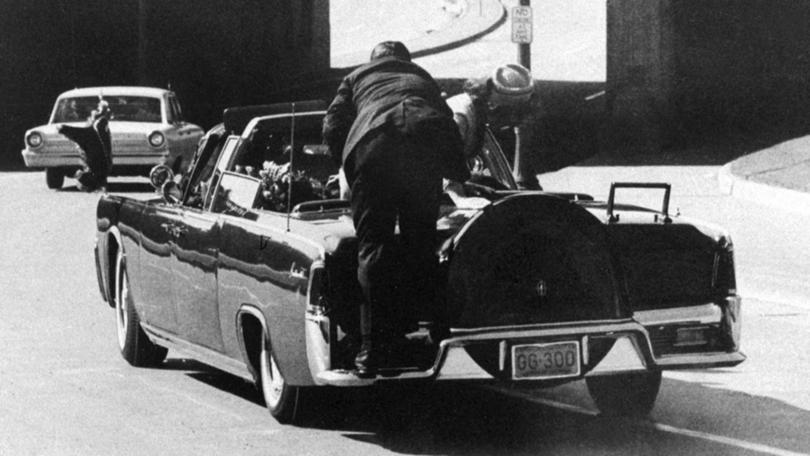Clint Hill: Secret Service agent who tried to save JFK after Dallas assassination dies aged 93

Clint Hill, the US Secret Service agent who leaped atop John Kennedy’s limousine to shield the mortally wounded president and long wondered if he could have saved him by acting quicker, has died at the age of 93.
Hill, who was seen in film footage of the assassination scrambling across the back of the presidential limousine to reach the president and his wife, Jacqueline, had died peacefully at home, the family said in a statement on Monday.
“Hill’s heroism on November 22, 1963, during the assassination of President John F. Kennedy, made him a worldwide symbol of courage and a revered icon in the US Secret Service,” the statement said.
Sign up to The Nightly's newsletters.
Get the first look at the digital newspaper, curated daily stories and breaking headlines delivered to your inbox.
By continuing you agree to our Terms and Privacy Policy.A native of North Dakota, Hill had been part of Dwight Eisenhower’s presidential protection detail and considered it a demotion when he was assigned to president-elect Kennedy’s wife in 1960.
But in November 1963, the 31-year-old, five-year veteran of the Secret Service became a part of history.
He was alternately jogging alongside the Kennedys’ limo, standing on its rear running boards or riding on the running boards of the car directly behind it as the presidential motorcade rolled past a cheering crowd in downtown Dallas that day.
While near the Texas School Book Depository Building, Hill heard what he first thought was a firecracker and then saw Kennedy lurch and clutch his throat.
As Hill sprinted from the trailing vehicle, the president was struck by a second and third shot as Hill crawled on to the back of the Kennedys’ accelerating car.
A 26-second film shot by bystander Abraham Zapruder, which is considered one of the key chronicles of the assassination, captured Hill jumping onto the presidential limo - the only Secret Service agent to rush to the vehicle.
He directed the blood-spattered Mrs Kennedy, who appeared to be crawling toward the rear of the car to collect bits of the president’s head, back to her seat and then covered them both with his body as the limo sped away.
At Parkland Hospital, where Kennedy would be pronounced dead, Hill said the first lady was reluctant to let go of her husband’s body until Hill took off his suit jacket and covered Kennedy’s horrific head wound with it.
Shortly after that, another Secret Service agent told Hill the president was dead, and he then found himself on a hospital telephone talking to Kennedy’s brother, Attorney General Robert Kennedy.
“He said, ‘Well, how bad is it?’” Hill recalled in a 2013 CBS News interview.
“Well, I didn’t want to tell him his brother was dead. I didn’t think it was my place. So I said, ‘It’s as bad as it can get’. And when I said that he hung up the phone.”
Hill, who would be near Mrs Kennedy for the next four days, then called a Dallas funeral home to get a casket for Kennedy and later helped load it on Air Force One for the return to Washington. He also accompanied the body and Mrs Kennedy to the autopsy.
During a private viewing of the body and at Mrs Kennedy’s request, Hill found a pair of scissors so she could cut off a lock of Kennedy’s hair before burial.
Hill was given a citation for his work but, like other agents in the detail that day, he was troubled by thoughts of what he should have done.
Alcoholism, depression, alienation and nightmares overtook him in the following years.
In a tearful 1976 interview with Mike Wallace for CBS’ 60 Minutes, he regretted not reaching the car in time to take the third shot himself.
“It was my fault,” Hill said.
“If I had reacted just a little bit quicker ... I’ll live with that to my grave.”
Wallace would later write that he had “never interviewed a more stricken and tormented man” than Hill.
In the 2013 CBS interview, Hill said he found a degree of redemption when he returned to Dallas in 1990, walked through the area where the shooting occurred and went into the school book depository building that assassin Lee Harvey Oswald used as his sniper’s perch.
“And after a couple hours I came away knowing that I did everything I could that day,” he said.
“But I still had that sense of guilt and responsibility because I was the only one who had a chance and I was unable to do anything.”
Hill said in his 2014 book Five Days in November that he did not support theories that Oswald had accomplices or was not the real killer.
After the assassination, Hill continued as a guard for Mrs Kennedy, with whom he had grown close, before being reassigned to Kennedy’s successor, Lyndon Johnson, and later Vice President Spiro Agnew during the Nixon administration. He retired from the Secret Service in 1975.
With his wife, journalist Lisa McCubbin, Hill wrote four books about his experiences.
